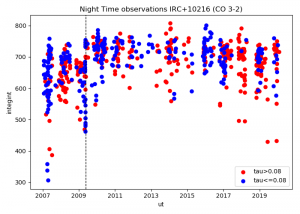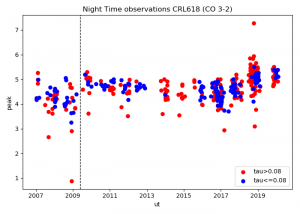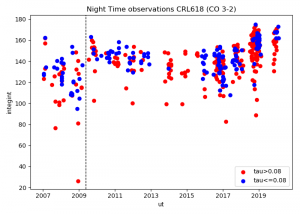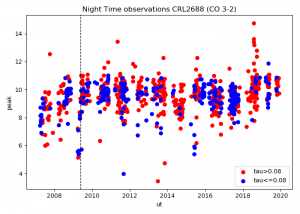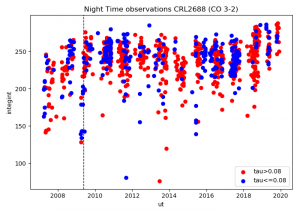The figures below show the results of CO(3-2) observations of the standard sources CRL2688, CRL618, and IRC+10216, which most often are used to check the performance of the JCMT. Left is the integrated intensity and right the peak antenna temperature (only for 1000 MHz because the ORAC-DR output file log.standard currently lists the highest noise peak in the recipe REDUCE_STANDARD). Observations made in good weather (tau<0.08) are indicated in blue; those made in worse conditions are indicated in red. All data was taken at night time between 19:00-9:00 (HST).
Note that HARP standard observations (and therefore all HARP observations) made before 20090521 are less reliable than those after that date because of a change in the pointing method. Before this date HARP pointing was done in AzEl coordinates whereas science observations were done in RaDec coordinates. This could cause a rotation of the K-mirror and a considerable pointing error. After 20090521 pointing was done in RaDec coordinates. A good pointing model for the K-mirror was only obtained on May 1, 2014.
The table below contains the average spectra of all good quality observations obtained between April 2007 and November 2018.
Good quality means line temperatures which are internally consistent and also consistent with RxB3/DAS data (if existing), and with good baselines.
The spectra were added with ORACDR (using the narrowline or broadline recipe. In both recipes a first order baseline is subtracted.
For the moment only 250 and 1000 MHz bandwidth spectra were summed (resolution 30 and 488 kHz). The numbers in brackets are the peak TA* (when necessary after rebinning) and the number of good observations existing for the particular combination.
For C18O and 13CO 250 MHz observations were added where these lines were observed in two subband mode (resolution 60 kHz). These are distinguished by an s.
All spectra show identifications of lines in the band. The identified lines are those which are listed in JCMTOT (and therefore in SPLAT).
The sdf files with the spectra are available on request.
*For the current values used in our ORAC_DR software please visit our: Starlink index.standard page





